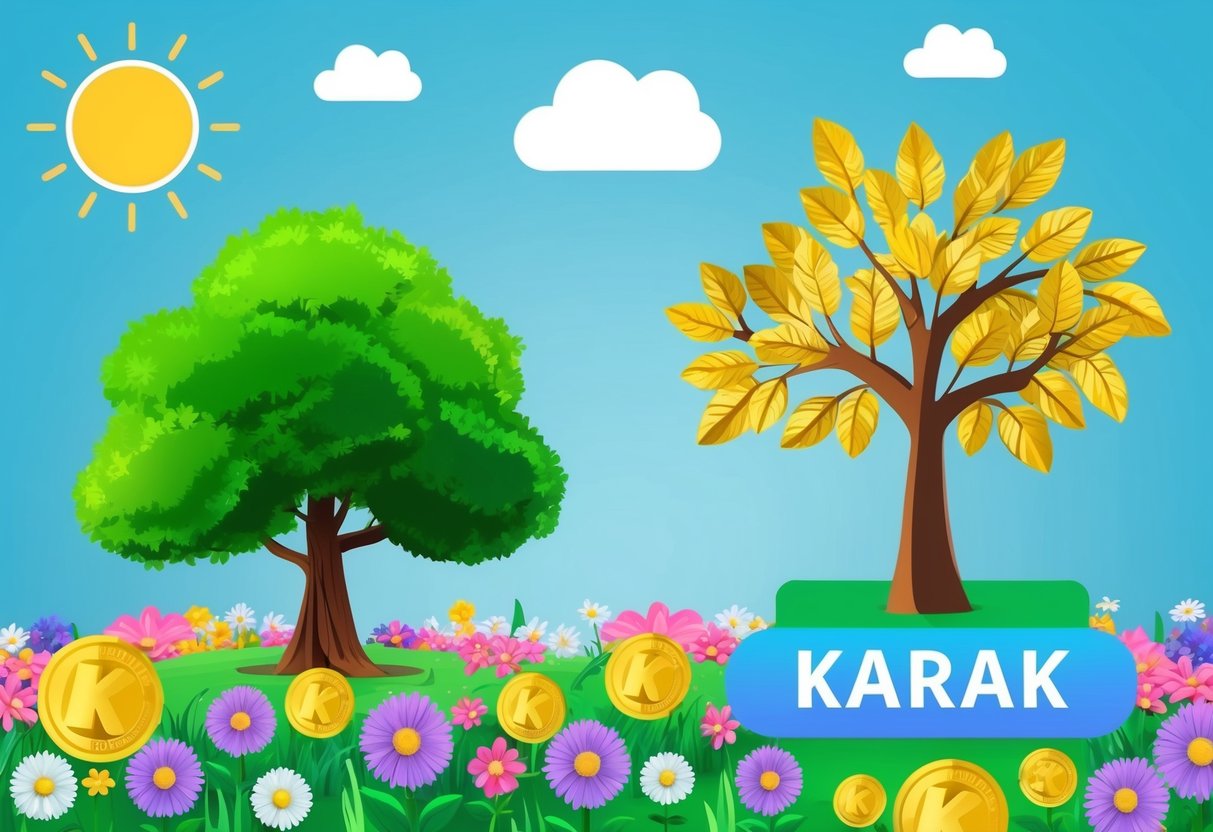
The Karak Staking Airdrop gives users a chance to earn free $KAR tokens by staking their tokens, stablecoins, or liquid tokens through the Karak Network’s platform. This airdrop is designed to reward participants for supporting the network and helping increase its security across multiple blockchains. By collecting Karak XP points, users can boost their potential rewards.

The Karak Network’s program stands out because it welcomes a variety of assets, not just one specific cryptocurrency. This makes it more accessible to many people in the DeFi space. Users looking to maximize their benefits can get involved early, follow staking steps, and track their XP.
The airdrop has gained attention for its practical approach and clear reward structure. Anyone curious about earning $KAR tokens or learning how restaking can work for them will find this guide helpful as they get started.
Today’s Airdrop Checker Even: Step-by-Step Claim:
🌐 Step 1: Visit the Official Airdrop Reward Page.
Dive into the action by heading to the official airdrop page, where all live events are waiting for you. Log into your account by connecting your wallet from any MOBILE DEVICE.
📱 Step 2: Use Your Mobile Wallet
Eligibility checks are mobile-exclusive! Grab your smartphone and ensure you’re using a mobile wallet to participate.
💎 Step 3: Meet The Eligibility Criteria
Make sure your wallet isn’t empty or brand new—only active wallets qualify. If one doesn’t work, don’t worry! Try again with another wallet to secure your rewards. You can claim many rewards from multiple wallets, so try to use multiple wallets to increase your chance to claim.
💰 Step 4: Withdraw The Tokens
After signing the approval from your wallet, wait 5 to 10 minutes, and then congratulations! You will see a token claim in your wallet. You can easily exchange your tokens from SushiSwap, PancakeSwap, and many more.
What Is Karak Staking Airdrop?

Karak Staking Airdrop is designed to reward users who stake or restake their assets on the Karak Network using its blockchain-based protocols. It connects with popular decentralized finance (DeFi) platforms, primarily leveraging the Ethereum blockchain for increased security and utility.
Purpose and Value of the Airdrop
The main goal of the Karak staking airdrop is to encourage users to participate in the network. By offering rewards in the form of $KAR tokens, Karak aims to increase user engagement and decentralize the network.
The airdrop functions as an incentive for both current and new users. It helps attract diverse participants, which strengthens network security and usage. The distributed tokens hold value in the ecosystem. Users can trade, stake further, or use them within other DeFi platforms.
Key points:
- Rewards users who contribute to the Karak protocol
- Helps distribute tokens more fairly
- Increases adoption of Karak within the wider blockchain community
How Karak Integrates with Ethereum and DeFi
Karak is built on top of the Ethereum blockchain. This integration allows the protocol to leverage Ethereum’s security features while benefiting from its wide adoption and active user base.
By connecting with Ethereum, Karak can interact with many DeFi products. This means that users can restake various Ethereum-based assets. It also allows the use of Karak’s features across multiple popular DeFi platforms, helping participants maximize their exposure to rewards.
Some DeFi applications that can interact with Karak include:
- Decentralized exchanges (DEXs)
- Lending and borrowing protocols
- Yield aggregators
Overview of Staking and Restaking Protocols
Karak uses both staking and restaking protocols. Staking is when users lock up their tokens to support the network and, in return, earn rewards. This is common in many blockchain projects, especially those built on Ethereum.
Restaking adds another layer. Users can stake their already staked assets again to provide extra security or utility to Karak and other partner networks. This approach gives users more chances to earn rewards without increasing their risk too much.
The protocol is designed to be flexible. Users can participate with different types of assets. Participating in staking or restaking makes users eligible for the Karak airdrop and other potential rewards in the ecosystem.
Eligibility and Claim Process

Karak staking airdrop participation is open to users who meet specific criteria, such as staking tokens, connecting a wallet, and sometimes using an invite code. Community involvement and earning points directly impact eligibility and reward size in the airdrop.
How to Qualify for Karak Staking Airdrop
Users must begin by registering on the Karak restaking page. Once there, they need to provide accurate information and follow the registration steps. Typically, registration includes verifying user credentials and agreeing to the platform’s basic requirements.
After registration, selecting a staking pool is required. Each pool may have different rules or rewards, so reading the details is important. Staking crypto tokens in an eligible pool is a must. Only stakers who have locked their tokens will be considered for the airdrop.
Completing any extra tasks set by Karak or its community may boost the chances of receiving an airdrop. Tasks can include simple actions like joining community groups or participating in ongoing events.
Earning Points and Additional Yield
Earning points is a core part of increasing a user’s eligibility and potential rewards. The Karak platform often gives experience points (XP) or other score types for actions such as staking tokens and completing platform-specific activities.
The more points collected, the higher the possible allocation of airdrop tokens. This encourages users to stay active and engaged with the platform and its community. Stakers may also receive extra yield in the form of Karak’s own tokens, increasing the total value from their investments.
Points and rewards usually update in real-time, letting users track their status on the platform dashboard. Active participation leads to better chances for higher airdrop rewards compared to passive users.
Using Invite Code and Connecting Your Wallet
An invite code is often required for new users to access the airdrop process. For example, using the code bkaaC during sign-up grants access to Karak’s staking features and the potential airdrop.
Connecting a compatible crypto wallet is the next step. Supported wallets allow users to sign in securely and manage their staked assets on the platform. Without a connected wallet, users cannot stake tokens or participate in airdrop activities.
All steps, including entering the invite code and connecting the wallet, must be completed to meet eligibility for the airdrop. After setting up, ensure the wallet has the needed tokens for staking and monitor updates for the latest airdrop information.
Benefits and Innovation of Karak Staking

Karak staking brings new ways for users to grow their assets and support decentralized finance networks. It focuses on rewards, effective use of funds, and ways for the community to help make decisions.
Yield Opportunities and Staking Rewards
Karak allows users to stake tokens, liquid tokens, and stablecoins across different networks, giving them many options to earn. Stakers can receive Karak XP points, staking rewards, and sometimes even EigenLayer points. These rewards encourage active participation and reward users over time.
Participants in the Karak airdrop have the potential to earn $KAR tokens, the network’s governance token. Earning rewards is not limited to a single asset, which means users can benefit from multiple streams at once.
Users who restake assets are eligible for higher returns. This multi-asset approach offers flexibility and helps users maximize their yield from different DeFi applications in a single place.
Capital Efficiency and TVL Growth
Karak innovates by introducing multiasset restaking, which allows funds that are already staked elsewhere to also be used on the Karak platform. This feature increases capital efficiency because the same assets can secure more than one protocol at a time.
The platform’s ability to accept various types of tokens and liquid staking derivatives helps users keep their assets active. This encourages higher total value locked (TVL) since funds remain invested and productive.
As more users restake their assets, Karak can attract increased TVL and support broader DeFi ecosystem growth. The platform’s model makes it possible for users to keep their funds earning while supporting new networks and services.
Decentralization and Governance
Karak’s governance relies on its own token, allowing community members to vote on upgrades and important changes. This ensures decisions are spread across many users, supporting decentralization.
The protocol makes it simple for anyone holding the KAR governance token to participate. Key topics for governance include reward structures, update proposals, and network security.
By giving users a voice in network management, Karak avoids central control and encourages a diverse group to set future directions. This governance model is open and relies on the wider community for support and decisions.
Karak Ecosystem and Future Prospects
Karak has built a staking and restaking platform designed to support various crypto assets and connect with major blockchain networks. It focuses on flexibility, security, and broad compatibility, aiming to serve both individual users and protocols.
Integration with Ethereum Ecosystem and Layer 2 Solutions
Karak is tightly linked to the Ethereum ecosystem. Users can stake ETH and various ERC-20 tokens directly into the platform. This integration gives access to wide pools of liquidity and established DeFi protocols like Ethena and ethfi.
Layer 2 scaling solutions—such as Arbitrum and Optimism—are important for Karak. They help bring lower gas fees and faster transactions, making staking more practical for smaller users.
Smart contract compatibility on Ethereum also means that projects can use Karak’s services to secure assets, restake, and deploy more complex DeFi strategies. This lowers friction for development and onboards more users from across the Ethereum community.
Cross-Chain Expansion and Supported Assets
Karak plans to extend its platform across multiple blockchains. Support for public chains like Solana, Sui, and Injective will bring new token types and users into the ecosystem.
Restaking and liquid staking options will not be limited to Ethereum assets. Users can deposit stablecoins, derivatives, and other liquid assets from supported chains to earn rewards and Karak XP. This flexibility allows DeFi participants to optimize their returns and spread risk across networks.
A growing list of supported assets and blockchains can make Karak more resilient. Cross-chain capability lets Karak tap into unique user bases, adding to its liquidity pools and boosting protocol security.
Potential Impact on Exchanges and DeFi
If Karak succeeds in increasing staking options and making them liquid, it could affect how users interact with centralized and decentralized exchanges. Liquid staking and restaking products may reduce the need to hold assets directly on exchanges—potentially improving user security.
DeFi platforms might integrate Karak’s yield solutions into their services. This could lead to new products like derivatives based on restaked positions or integrations with yield aggregators like Yieldnest. Stablecoins might also find new ways to earn yield through Karak.
Broader adoption across exchanges and DeFi products can create more opportunities for users to access rewards, lowering barriers to staking and making DeFi more accessible to all types of investors.
Frequently Asked Questions
The Karak staking airdrop process involves specific steps like staking or restaking assets, using access codes, and earning XP. Timing, value, and recent updates are common concerns as users prepare and interact with the community.
What is the expected value of the Karak staking airdrop?
The exact value of the airdrop is not confirmed as of April 2025. The value will vary depending on factors such as the number of participants, the total XP earned, and the token price at listing. Users are encouraged to monitor official announcements for updates.
Where can one discuss the Karak staking airdrop with the community?
Users can discuss the Karak staking airdrop on platforms like Discord, Telegram, and X (formerly Twitter). These channels often have dedicated groups or official handles where participants share tips, updates, and questions about the airdrop and the network.
How can participants calculate their potential rewards from the Karak staking airdrop?
Potential rewards depend on several factors, including how much is staked, the duration of staking, and total XP earned. Some unofficial calculators may appear online, but the most reliable information will be released by the Karak Network before the airdrop distribution. Checking the official Karak website or app is recommended for the latest calculation tools.
When is the Karak airdrop scheduled to take place?
As of now, a final date for the Karak airdrop has not been publicly announced. Users are advised to follow the Karak Network’s official communication channels for the most up-to-date schedule information.
What are the recent updates on the Karak Network’s development?
Karak Network continues to expand its staking and restaking features, preparing for multi-chain support and improving the user interface. Recent updates include smoother wallet integration and more options for earning XP, such as referrals and participation in new pools.
Can you provide information on the process for the Karak bridge?
To use the Karak bridge, participants need to visit the official web application, connect a compatible wallet, and follow the interface prompts to bridge assets. The bridge allows movement of supported tokens between Karak and other networks, as part of the broader restaking ecosystem. Always confirm wallet addresses and network details before transferring assets.
Leave a Reply